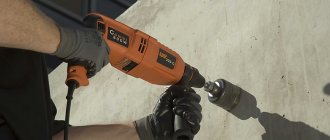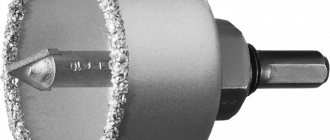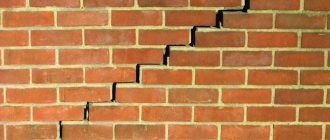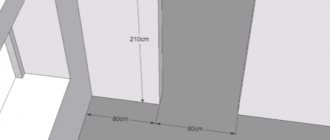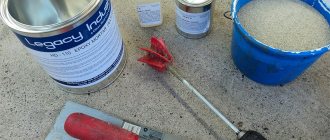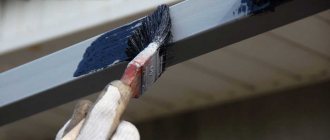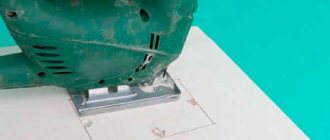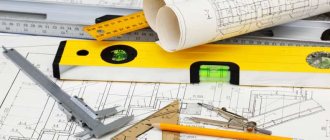Drilling brickwork will require some special knowledge and suitable tools from the master. You will have to work with particularly durable material, so do not forget a simple and important rule - use a cutting drill bit stronger than the brick itself. Inexperienced owners are advised not to immediately take up a drill, but first consult with a professional builder and master the tricks of drilling a brick wall. - a powerful impact drill or hammer drill; - a Pobedit drill; - dowel; - metal detector; - screwdriver; - core drill; - container with cold water; - safety glasses or a shield. Prepare the tools necessary for drilling a brick wall.
You will need an electric drill with a power of at least 600 W, with an impact function. Brick can withstand static loads well, but does not like sharp impacts. A professional hammer drill is a good option if you have the opportunity to buy or rent one.
When working with the tool, follow the manufacturer’s recommendations. Buy a pair of drills with a diameter of 6 and 8 mm, always with surfacing made of pobedit (an alloy of cobalt and tungsten). This cutting tool does not require pre-sharpening; it is specially designed for very dense surfaces. Finally, if necessary, select a dowel for solid brick from a hardware store according to the size of the drill used. Consider the location of the future hole in the brick wall.
Carefully examine the surface you are going to perforate - it is important to avoid damage to internal electrical wiring, water pipes and other pitfalls. The easiest way to avoid bumping into an obstacle when drilling is to check the surface with a metal detector. If you do not have a special device, mark all sockets, switches and lamps. Typically, wires run from them to the junction box along a vertical line, although some electricians run them diagonally.
To protect yourself and timely detect communications recessed in the plaster, make the first 10-20 mm of the hole length manually (for example, using a screwdriver). Proceed very carefully. Mark the future hole with a core (a special device for marking holes for drilling) to fix the drill in the first stages of work. Be sure to wear safety glasses or a welding shield to protect your eyes from dust and hard brick fragments. When drilling into a brick wall, keep the tool straight, otherwise the drill bit may break.
To ensure even drilling of the brick, apply gentle pressure on the drill. Even the most powerful machine will experience heavy loads when working with such a wall, so the drill must be cooled. To do this, immerse it in cold water, but carefully protect the electrical mechanism itself from moisture. Suggestion from our partner If possible, try drilling not into the brick, but into the hardened cement in the seams. This will make your task much easier and leave the masonry intact. You need to know how to drill walls: drilling bricks How to drill a brick wall
To drill a brick wall, it is not necessary to invite specialists; if you put in some effort, you can do everything yourself.
The question of how to drill through a brick wall interests many. This can be done, and it is not necessary to have special skills, but you must follow the recommendations. You will have to work with a very durable material, which means following the important rule of doing the work only with a drill, which is much stronger than the brick itself.
Drilling a brick wall has some tricks, so before you begin this process, you need to study them. How to drill a brick wall with your own hands? First of all, you need to prepare the following tools:
Drilling a brick wall is a rather complicated process; it will require a drill with a drill made of hard alloys, tungsten and cobalt.
- A very powerful drill with excellent impact action and a hammer drill. Pobedite glass. Metal detector. Dowel. Core. Screwdriver. A container into which you need to pour cold water. Shield and safety glasses.
How the process is carried out
The hammer drill must be powerful with special devices.
A drill for drilling a hole must have a power of at least 600 W; be sure to choose a tool that has an impact action. It must be assumed that a material such as brick has the ability to withstand static loads very well, but it does not withstand strong impacts well, so they should be avoided when drilling.
To drill a hole with maximum precision and accuracy, you need to use a professional hammer drill. It is not cheap, so there is no point in purchasing it for a one-time job; it is easier to rent it. It is not safe to work with such a tool, so you should carefully read the instructions from the manufacturer.
It is necessary to purchase a drill whose diameter is from 6 to 8 mm; you need to take only one that has a surfacing made of pobedit (this material is an alloy of tungsten and cobalt). The tool has cutting properties; no pre-sharpening is required; it can effectively work with hard surfaces. Most hardware stores offer dowels for solid bricks according to the size of the drill used.
Markings for drilling are made with a core.
The location of the hole in the brick wall needs to be thought out in advance. The surface must be examined in advance.
When drilling, you need to exercise maximum caution; under no circumstances should you damage electrical wiring or water pipes, as this can lead to negative consequences. To ensure that drilling into the wall is as safe as possible, you should first check everything with a metal detector. If such a device is not at hand, then all sockets, switches and lamps must be pre-marked.
To maintain safety and in order to detect communications recessed in the wall in time, the first 20 cm of the hole length must be made manually (this way you can drill the wall using a screwdriver). But we must act with the utmost caution.
The future hole for drilling must be marked with a core (this is a special device designed to make marks for drilling).
This must be done so that the drill is fixed in the first stages of work. Safety precautions must be strictly observed, which includes wearing safety glasses or a welding shield. With their help you can protect your eyes from dust and hard brick fragments.
Return to contents
Forming a hole for a pipe using construction components
In addition to the tool, you need to be able to choose the right nozzle. Usually for one tool there are several sets of drills and attachments for different types of work. Even for one action, manufacturers offer several options for how it can be carried out.
Drill
A drill for a power tool when working with a solid wall should have a Pobedit tip. The material is characterized by high strength and abrasion resistance.
Compared to similar drills made from other raw materials, Pobedit drills last longer. They are used many times.
Brick drills
The standard length of the element is 15 cm, intended purpose is household use. There are larger models for rotary hammers, the largest ones are called auger drills.
It is possible to make the desired hole with such a nozzle if you draw a circle. Then drill holes along the contour in 1 cm increments. The core is removed with a chisel and hammer.
This is the way out, if you don’t have a special drill for a hammer drill, have a spatula - it can be used to easily remove the central part.
